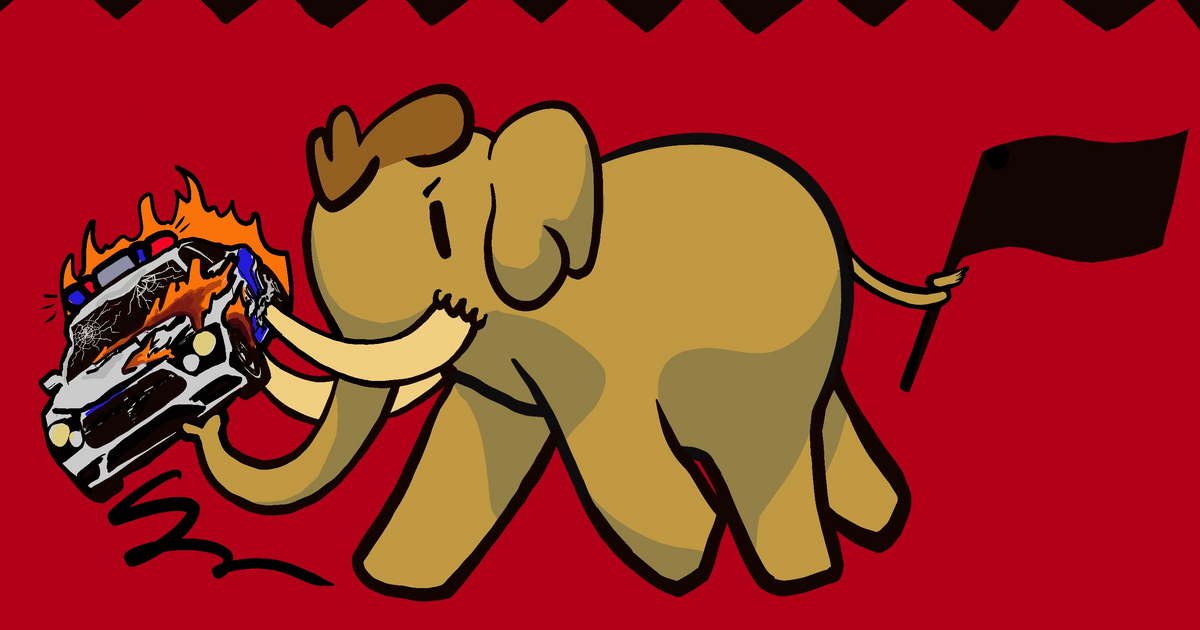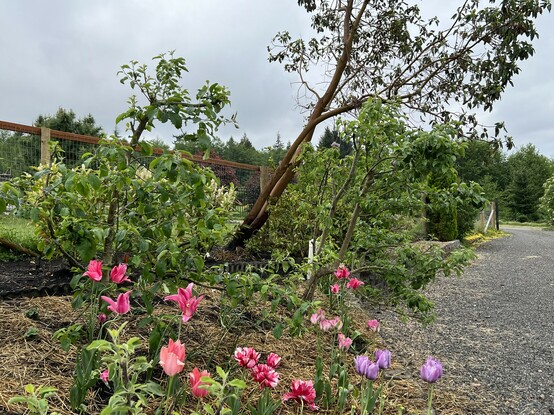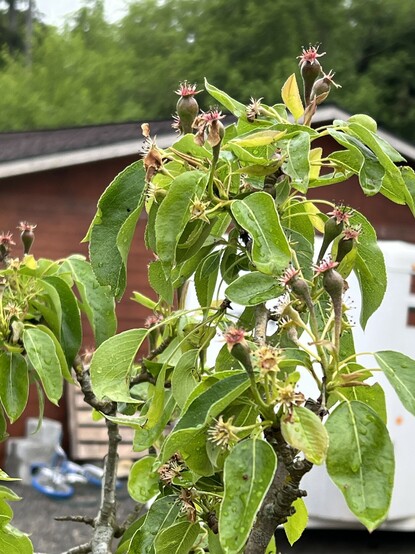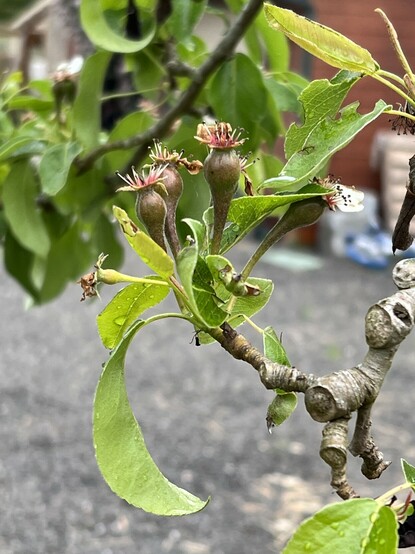#watercolor #watercolour #aquarelle #aquarell #aquarello #fruit #pears #leaves #branches #painting #art
Recent searches
Search options
#pears
#watercolor #watercolour #aquarelle #aquarell #aquarello #fruit #pears #leaves #branches #painting #art
The Comice pear, the oldest Gravenstein apple, an early blooming peach grown from seed, and the Harcot Apricot. I saw quite a few apricots blooming when I was out and about today. The Japanese type plum here is a couple of warm days away from starting to bloom and it doesn't look like it's died much more. It's more than 50 years old.
#bloomscrolling #fruit #orchard #pears #Iowa
The Seckel Pear tree is a couple of days away from blooming. (First blossoms last year were very early — March 31.)
The young leaves are just exiting the phase described by #RobertFrost:
“Her early leaf’s a flower;
But only so an hour.”
Say goodbye to sad, forgotten pears and hello to frozen perfection.
#pears #lifestyle #food preservation #juice #food & dining
https://bagelsandlasagna.com/freeze-pears/?utm_source=flipboard&utm_medium=activitypub
Posted into Cooking Tips & Tricks @cooking-tips-tricks-Leah_ingram
#watercolor #watercolorfruit #art #fruit #pears #botanicals
#watercolor #watercolorfruit #art #fruit #pears #botanicals
A little dessert with lunch. #Pears
Remember that 40 lb harvest last Fall? Living on the produce now.
#GrowYourOwn #Seed to #tree to #fruit
Two trees, first year producing
So am on a day in day out schedule re allotment. Today an IN and found the pond mostly empty, meaning the sheet is leaking. Bah! Annoying. Spotted a dragonfly checking out what's left of the water.
Dowsed the internal beds, where beans, strawberries and tomatoes are OK though slow.
Proceeded to transfer 15 butter beans to outdoors, laid them in three rows of five, want to check how'll they fare, the rest indoors for safety.
Spuds are also growing outside, again, slow. Pears and apples have made an appearance and are growing well, by the looks of it.
#allotment #gardening #nature #photography #wildlife #chilli #tomatoes #apples #pears #orchard
"Make Your Yard #NativeBee Friendly
"Perhaps you too have noticed fewer bees in your garden or orchard and are looking for ways to create or improve habitat for them.
- Choose nonchemical solutions to insect problems. Most #insecticides are highly toxic to bees. For information on nonchemical insect pest management, see our Habitats fact sheet, Beneficial Insects and #Spiders in Your #Maine Backyard (bulletin #7150).
- Curb the “‘erb.” Avoid using herbicides. The long-term negative health effects of #herbicides on humans are not fully known. Tolerate, in fact, appreciate the beauty and usefulness of flowering 'weeds' such as dandelion. Their presence means more variety of nectar and pollen sources for native bees and others, such as butterflies. They help fill gaps in the succession of planted flowers, and add to the variety of flower shapes, colors and scents.
- Provide a source of pesticide-free water and mud. A birdbath, dripping faucet or mud puddle works nicely for bees and attracts butterflies and beneficial insects. To assure a clean source of water, change the water in your birdbath frequently, at least once a day. This will also prevent mosquitoes breeding there. Mud is an important nesting material for several bee species.
- Establish set-asides and hedgerows. Bees need undisturbed areas for nesting. Hedgerows or a bit of clutter, such as brush piles of sumac or raspberry canes, can make a safe nest area for them. Set-asides may be areas that are not mowed and are left undisturbed. They could be bare ground, preferably with a sunny, southern exposure ideal for certain species’ nesting requirements. Lack of appropriate nest sites is a limiting factor on population.
- Provide conservation bee nesting houses.
- Minimize lawn area, or mow less often. Mowing grass often kills bees. To avoid this, mow when they are not so active, when it’s cool, overcast and windy, or late in the evening. Allowing the lawn to revert to a more natural state, by not mowing or reducing the area that is mowed, will result in a profusion of bee forage and more potential nest sites over time. Areas that are not mowed become set-asides and may be colonized by many flowering plants.
- Maximize flower space and plant species diversity. Have gardens, fruit-bearing trees and shrubs, thickets and hedgerows of flowering shrubs, and set-aside areas in your yard. This diversity will provide flower shape variety, a greater quantity of pollen and nectar, and a succession of flowering times.
- Provide a succession of blooming plants throughout the growing season. Food plants are an essential habitat requirement for bees and must be available early, middle and late season. Some native bees are actively forging adults by March and others are active until early November. Bumble bees are a good example of the importance of succession blooming. From early spring until late fall they require nectar and pollen; the number of queens a colony produces depends on the number of workers that are produced in midsummer, which in turn depends on the availability of high quality nectar and pollen.
- Provide a mix of flower shapes to accommodate different bee tongue lengths. Small bees, such as the halictids, have short tongues; other species have long tongues. Asters and other composites nicely suit short-tongue bees, but tubular flowers with long corollas are only suitable for species with long tongues. Flower size is not an indication of the quality or quantity of nectar.
- Include lots of purple, blue, and yellow flowers in your bee sanctuary. These are the most attractive colors to bees. Planting the colors in masses will get their attention!
- Emphasize native perennial plants. Perennials generally are richer nectar and pollen sources and, because they bloom year after year, they provide a more dependable food source than annuals, which must be replanted each year. Our native bees have evolved with our native plants, to mutual benefit.
- Avoid horticultural plants, such as marigolds and roses, bred as 'doubles.' These plants have been bred for more showy petals in place of anthers. Thus, they have little or no pollen. Also, the many petals often make the nectar physically inaccessible to bees, #butterflies, #hummingbirds and others.
- Select sunny locations, sheltered from the wind, for your flower plantings. Smaller bees, especially, use the sun to help warm their bodies. Also, plants receiving at least six hours of sunlight have more nectar than those receiving less.
- Remember that early spring and late autumn are very challenging times for bees because of coolness, highly variable temperatures and a lack of flowers. In the spring, tolerate those #dandelions. In the late fall, let the bees and migrating monarch butterflies have the few remaining flowers. Leaving #FallenFruit to rot, such as windfall #pears, may help too, but be aware that you will also be attracting hungry #wasps.
- Practice peaceful coexistence. Bees sometimes choose to nest in inconvenient places. Rather than exterminating them, think of it as an opportunity to see and learn about them up close."
Have you considered the fascinating names of older varieties of fruit as writing prompts?
Eating PEARS: Jargonelle, Swan’s Egg.
Perry PEARS: Bartestree Squash, Gregg’s Pitt.
Eating APPLES: Pig’s Nose Pippin (described by Hogg in 1884), Stoke Edith Pippin, Yellow Ingestrie.
Cooking APPLES: Byford Wonder, Herefordshire Beefing (from "beau fin").
Dual purpose APPLES: Collington Big Bitters, Crimson Quoining.
Cider APPLES: Redstreak, Foxwhelp.
Other APPLES: Ball’s Bittersweet, Brown Snout, Lady’s Finger of Hereford, Strawberry Norman, Wormsley Pippin.
Fruit trees, 3/3
The #pears didn’t pollinate, except for that one grafted branch that bloomed a different week. It’s loaded with fruit!
The uphill pear still needs heavy pruning. I took at least a third off of all of these trees last fall, and they’re gonna get the chop-chop again this fall. They look pretty good though! And healthier than the peach and nectarine!
I’m keen to find some more #punk folk on here but realise the word means so many different things to people. So was wondering what punk #music means the most to you? Who are the #bands that you come back to time and time again?
For me I’m forever marked by the childhood induction into the scene through a holy trinity (to me) of #DeadKennedys #BadReligion and #GreenDay that gave me an enduring love for political, thoughtful, but melodic and harmony-strewn music with a good dose of introspective personal stuff thrown in for good measure.
Becoming a punk in the mid-90s, of course #NoUseForAName, #BouncingSouls, #Rancid, #Descendents, #Lagwagon, #Nofx, #Propagandhi, etc. became the soundtrack, but I also had #NoMeansNo, #BlackFlag, #SNFU, #TheClash, #Subhumans, #CitizenFish, #ActiveMinds, #Crass, #OiPolloi, #MinorThreat #Ramones and the local bands on the #Birmingham and UK scene to broaden my tastes. Had a big pop-punk love affair after touring Italy with #TheManges and #StinkingPolecats which led to inevitable obsessions with all things #LookoutRecords (#MTX, #ScreechingWeasel, etc.) and all those influences still stick with me today (even if some of the lyrics and songs - and band members - occasionally need some disavowing!).
More recent bands I love include #Idles, #TheWonderYears, #TheBobbyLees, #Pup, #MobinaGalore, #Pears, #WarOnWomen, #TheHomelessGospelChoir, #TheMuslims (band), #RottenMind, #BadCopBadCop, #TheVenemousPinks, #TheLindaLindas, #AntiFlag, #JeffRosenstock, etc…
Who else should I be listening to?




















